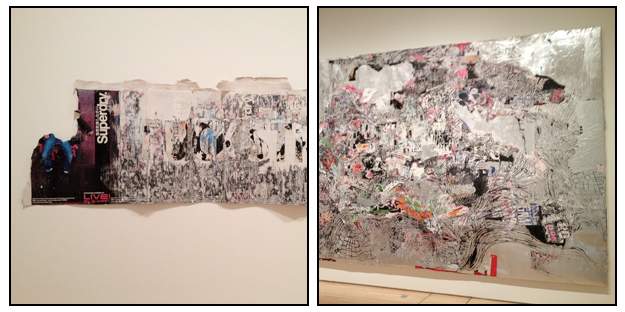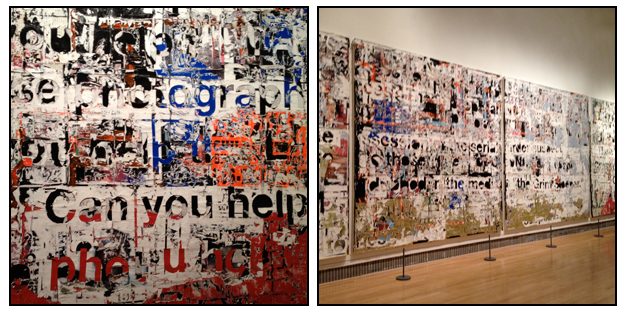
The Venues
On my most recent trip to the San Francisco Bay Area I attended the show Mark Bradford. It is being presented as a collaboration between San Francisco Museum of Modern Art (SFMOMA) and Yerba Buena Center for the Arts (YBCA), two Bay Area arts institutions. This co-presentation of the work, although not the first occurrence, represents an interesting partnership between two very different organizations. While SFMOMA has a longer history in San Francisco, being founded in 1935, YBCA is the product of a redevelopment project that began in the eighties. Now across the street from one another, the two organizations are as different as their histories. SFMOMA takes a much more traditional museum approach, while YBCA, without a permanent collection, represents a more innovative contemporary arts institution that, “bridges the seemingly contradictory worlds of pop culture, contemporary art, and community aesthetics.” [i] While both YBCA and SFMOMA present pieces by Bradford within a common show, my experience of the works at the two venues was completely distinct, perhaps allowing for a more whole encounter with the artist’s work.
The Artist
Mark Bradford was born in 1961 in Los Angeles where he continues to live and work. He attended CalArts in Los Angeles for both his BFA and MFA degrees. His work draws on materials from his surroundings incorporated into collage and painting. Some of his initial materials included remnants of products from his mother’s hair salon and went on to include additional sourced materials found in his Los Angeles neighborhood. While collage and painting remain his primary mediums, he has created video, photography and sculptural pieces.
The Visit

I started the morning by heading first to SFMOMA, which already had a line of visitors (mostly school groups) waiting to enter. I have never entered a museum at its opening and it felt completely full of potential; I was only slightly aware of Bradford’s work at the cusp of this visit and was excited for what I would find. I went straight upstairs to the Bradford exhibition and immediately as I arrived on the third floor, came across a very large arrangement of painted and collaged canvases which were arranged together, with small gaps, to create a single composition. The physicality of his work was apparent in the sheer size as well as the texture of the piece which included what looked like foil that had been traced onto. The gaps between each of the smaller canvases contributed to the collaged nature of the work, looking like an collection of smaller pieces. I took a picture.

Next I entered the main area of the exhibition which began with a room that displayed several records and a record player playing a loud recording. I tried to take a picture but despite my previous success was immediately scolded by one of the many guards who were on duty. There were quite a few other museum visitors about as well. The subsequent rooms featured mostly very large scale paintings and collages, usually only one per wall, three or four to room. Every piece seemed to take up an entire wall to itself. Each work exhibited a very material, textual presence exemplified by the use of layers upon layers of billboard paper, posters and signs as well as other scavenged materials representative of the kind of signage and paper-turned-waste found in and around South Central, Los Angeles. The work created a vocabulary of images, words, typography, and things that are critical actors in the landscape of this neighborhood. Together the materials recall Jane Bennett’s writing on assemblages, which “are living, throbbing confederations… [that] have uneven topographies… [and] are not governed by any central head,” going on to state that, “Each member and proto-member of the assemblage has a certain vital force, but there is also an effectivity proper to the grouping as such” [ii] which is interpreted in the meaning in each collage. As stated by SFMOMA curator, Gary Garrels, “the works seen here draw largely on fragments from these environments, such as permanent-wave endpapers, posters, acrylic, billboard paper, and photomechanical reproductions, in order to evoke in both materials and meaning, the social and political realities of contemporary urban life—particularly in South Central, where Bradford continues to maintain his studio.” [iii]
While the majority of the works were the type of collages and paintings described above, there was one video work presented. It showed a man from the neighborhood, being followed by Bradford as he walks down the street, allowing us an image of the human actors in this landscape. As he walked, one could see paper on the ground and the walls that demonstrates the link between the found materials on the canvases and the experience of traversing those streets.

After leaving SFMOMA, I headed over to YBCA for the next set of works by Bradford. YBCA was not nearly as packed. In fact, there were no other visitors, or museum guards in the room dedicated to Bradford while I was there. The lighting was less bright and I felt more intimate with the work, getting closer to the canvases than across the street at SFMOMA. The first room had just a few works, namely: another large canvas, a large wooden ark, Mithra, that took the grand scale of the previous works to greater dimensions, as well as a video of Bradford working on the ark. The ark was physically overwhelming, right in the center of the room, covered with billboard paper and other materials like in the other work, yet this time, the paper was peeling off on many of the edges. Only a section of the original work created in reaction to the events of Hurricane Katrina, its size dominated the room and its rough plywood and peeling paper reminded of the materiality of the work. The video of the ark in progress connected visitors to the process of assembling the materials and labor involved. It was the perfect culmination to the experience of Bradford’s work and process.

[i] “History | Yerba Buena Center for the Arts”, http://www.ybca.org/about/history. Apr. 25, 2012
[ii] Bennett, Jane. Vibrant Matter : a Political Ecology of Things. Durham: Duke University Press, 2010. p. 23-24.
[iii] Garrels, Gary. “Mark Bradford”. Curators Notes. Mark Bradford. San Francisco Museum of Modern Art, San Francisco 2012
https://vimeo.com/41323921
Link to the video I made of the projection of Bradford working on the ark “Mithra”